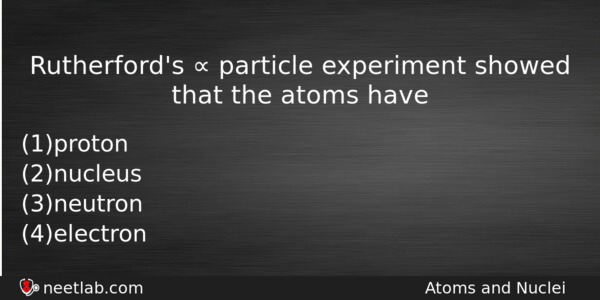| ⇦ | 
| ⇨ |
Rutherford’s ∝ particle experiment showed that the atoms have
Options
(a) proton
(b) nucleus
(c) neutron
(d) electron
Correct Answer:
nucleus
Explanation:
No explanation available. Be the first to write the explanation for this question by commenting below.
Related Questions: - A ball is projected upwards from the foot of a tower. The ball crosses the top
- A nucleus at rest splits into two nuclear parts having radii in the ratio 1:2.
- In the adiabatic compression, the decrease in volume associated with
- The condition under which a microwave oven heats up a food item containing
- A particle of mass ‘m’ is kept at rest at a height 3R from the surface of earth
Topics: Atoms and Nuclei
(136)
Subject: Physics
(2479)
Important MCQs Based on Medical Entrance Examinations To Improve Your NEET Score
- A ball is projected upwards from the foot of a tower. The ball crosses the top
- A nucleus at rest splits into two nuclear parts having radii in the ratio 1:2.
- In the adiabatic compression, the decrease in volume associated with
- The condition under which a microwave oven heats up a food item containing
- A particle of mass ‘m’ is kept at rest at a height 3R from the surface of earth
Topics: Atoms and Nuclei (136)
Subject: Physics (2479)
Important MCQs Based on Medical Entrance Examinations To Improve Your NEET Score
18000+ students are using NEETLab to improve their score. What about you?
Solve Previous Year MCQs, Mock Tests, Topicwise Practice Tests, Identify Weak Topics, Formula Flash cards and much more is available in NEETLab Android App to improve your NEET score.
Share this page with your friends

Leave a Reply